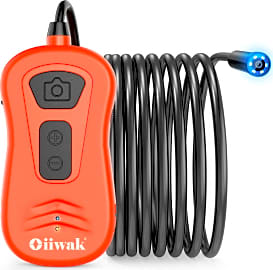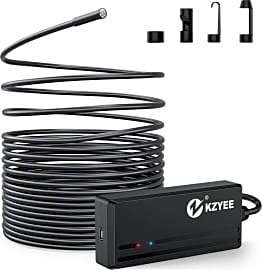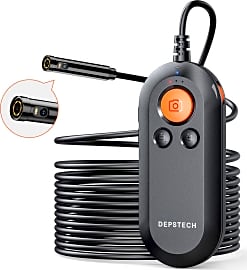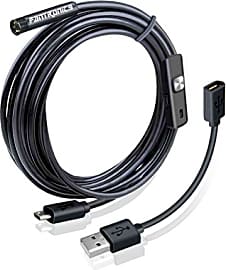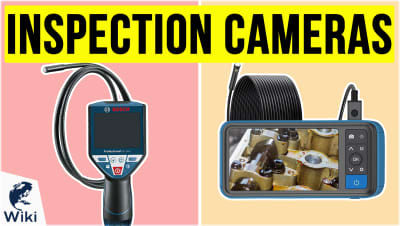The 7 Best Inspection Cameras For Android

This wiki has been updated 37 times since it was first published in January of 2017. Inspection cameras, also referred to as borescopes, or sometimes incorrectly as endoscopes, are excellent tools for capturing images or videos of inaccessible areas. The models we have selected for this list are all compatible with Android mobile devices by plugging in directly or connecting over a Wi-Fi signal. We've ranked the best options by their resolution, durability, and ease of use. When users buy our independently chosen editorial choices, we may earn commissions to help fund the Wiki.
Editor's Notes
November 12, 2020:
It's true that nearly any gadget that connects to another with a cord is now offered with wireless or Bluetooth connectivity, but not everyone sees this as a plus. While wireless or Bluetooth is often seen as a convenience, some users still prefer a wired connection, whether they just don't want to deal with the pairing process, or because they fear a poor connection could interrupt their work. For this reason, we still reviewed and included two wired options in our selections, the T Takmly USB 3-in-1 and the Fantronics OTG Micro USB.
For this update we added the Depstech Dual-Lens that allows users to see the area around the intended target at about a 90 degree angle. Although the picture quality is not as crisp as one usually expects from a Depstech inspection camera, it's an excellent upgrade for those who need to see multiple perspectives at once. And the app can even display both camera views side by side on a smart phone.
August 29, 2019:
In the time since our last ranking in this category, the industry has pushed hard to provide users with wireless options for their endoscopes, utilizing Wi-Fi connections to link their cameras with your smartphones. Since most people buying these are looking to use them for home DIY projects, this makes sense. Wi-Fi offers more bandwidth than Bluetooth, so it can more reliably transfer lag-free, high-resolution video content, and most homeowners will have a Wi-Fi network set up in their homes. If they don't, or if the user needs an inspection cam they can use outside the house, they can usually use the same smartphone they're employing as a monitor to set up a Wi-Fi hotspot.
Beyond the issue of connectivity, companies want to be able to boast the highest resolution, but this gets complicated by sensor size. Most companies will gloat about having a certain number of megapixels, but the more of those they cram on to a sensor that's roughly the same size (or smaller) than everybody else's, the worse that camera is going to perform in low light. The 5MP Depstech HD operates at about the best balance between sensor size and megapixel count, and it offers a base for power and Wi-Fi transmission that's actually comfortable to hold.
You may notice that we had to send a lot of the old models around here packing. That has a lot to do with a push towards more wireless models, but it's also due to availability issues with a number of previous contenders, including the wireless Rotek offering previously at number three. ViVida's AbleScope also left the list, as its price was unreasonably high for its specs, especially as the rest of the category gets more capable and less expensive.
History Of Endoscopes, Borescopes, And Inspection Cameras
However, other industries took this technology and ran with it, finding new uses for it in all manner of jobs.
The ability to look inside the human body has long been a prized skill, especially if you could do so without cutting into it first. In fact, primitive endoscopes were found in the ruins of Pompeii, suggesting that Roman doctors may have used them at one time (before that whole volcano thing happened, of course).
The first known verifiable endoscope came along in 1805 C.E. A German doctor named Philip Bozzini needed something to examine the urinary tract, so he created a special tube that was designed to channel light where he needed it to be.
One of these devices was used to examine the stomach of a living person for the first time in 1868, and not long after, another model was designed specifically for analyzing the bladder. There was only one issue with these devices: they weren't flexible. In fact, the person who had their stomach analyzed was a sword swallower, so you can imagine how difficult it would be to convince someone else to give it a try.
That problem wasn't solved until 1932, when a German gastroenterologist named Rudolph Schindler created a pliable model that could snake through a person's various tracts. A few decades later, in the 1950s, a team of doctors and scientists would create one that was fitted with a tiny camera, allowing for even better diagnoses to be made.
Since then, improvements to medical endoscopes have largely centered on improving the quality of the picture, and today you can get a better visual of your innards than you ever wanted to have. However, other industries took this technology and ran with it, finding new uses for it in all manner of jobs.
The models that are used for industrial applications are often called "borescopes," although they're basically the same thing. They're used by plumbers, architects, mechanics, and even bomb squad personnel to look deep into dark cracks and crevices without having to damage the exterior first.
Today, these tiny little inspection cameras are widely available to the general public, and everyone from contractors to home DIY-ers can buy one. Many hook up to your smartphone, allowing you to see — and record — anything you need to thoroughly inspect.
And the best part about them? They really make you feel like a high-tech James Bond, even if you're just trying to fish your wedding ring out of the drain.
Benefits Of An Android-Based Inspection Camera
If you work in a field that requires inspection of intricate machinery, you may already have a high-dollar dedicated borescope that you use regularly, making you wonder why you should bother with an Android-based model.
The fact of the matter is, however, that while these cameras may not be good enough to replace the expensive ones you already own, they still offer enough convenience to be more than worth their (relatively modest) price tag.
You'll likely still need that expensive borescope, as it can offer a visual quality that a phone-based model can't hope to match.
Since they're so small, you can easily carry them with you from job to job without having to lug around a whole separate toolbox. The cameras themselves can easily be rolled up and stashed in a bag inside your regular toolbox, and you have your phone on you anyway, so there's not much extra bulk to worry about.
That also makes them easy to grab when you need them, without having to fumble around your garage looking for a tool you rarely use. In the time it would take you to stop working and find your other borescope, you can have the camera uncoiled and plugged into your phone — and shoved inside that turbine or engine.
This not only saves time (and therefore money), but it also encourages you to actually use the thing more often. If finding your inspection camera is a chore, you're more likely to want to only grab it when it's absolutely necessary. If it's always close at hand, however, you have no reason not to use it to see down those pipes.
You'll likely still need that expensive borescope, as it can offer a visual quality that a phone-based model can't hope to match. However, having one of these little guys on hand can be incredibly useful — and if it breaks, it's a whole lot cheaper to replace than that pricey one.
The Future Of Inspection Cameras
While many of the innovations to date in borescope, endoscope, and inspection camera technology have focused on improving the quality of the image, there are several breakthroughs just over the horizon that may completely change how we use these handy little machines.
Technology advances so quickly that there's no telling what these machines will be able to do just a few years from now.
One of the biggest changes will be the addition of a working channel. This is a tube, separate from the camera, that can be fitted with whatever other instruments the technician may need. This can include mechanical instruments that allow you to make repairs remotely, much like we've seen in recent years with endoscopic surgery (which should also continue to improve).
In both the renewable-energy and aviation industries, power-blending technology will play a big role in the years to come. This allows technicians to fix dents in turbines immediately, and they can view their work on multiple screens — allowing for both better visuals and the chance to record the repairs for future reference.
Safety inspections will also see big changes due to improvements in boerescopes. Dye penetrant inspections especially will be affected, as many cameras will be fitted with both white and UV lights. The white light will allow the tech to navigate to the part under inspection, at which point they can switch over to the UV light to perform the analysis.
Of course, this is just the tip of the iceberg in terms of what may be in store. Technology advances so quickly that there's no telling what these machines will be able to do just a few years from now. One thing's for certain, however: you'll always pretend that you're a Navy SEAL preparing for a dangerous hostage rescue every time you use one.


